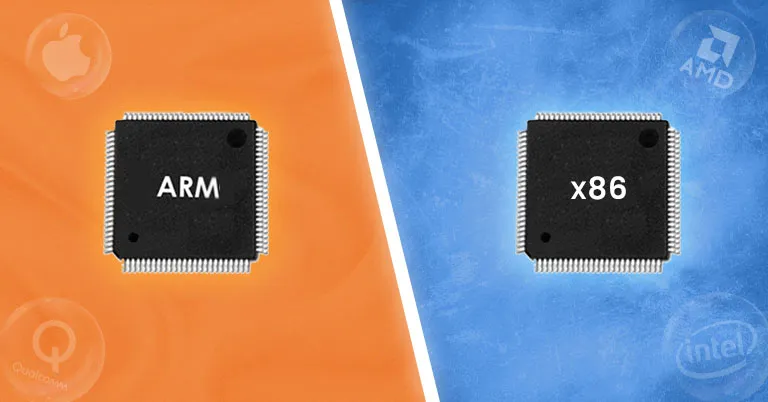ARM-Based Processors vs. x86 Chips: The Battle for Computing Power

Understanding Processor Architectures
Before diving into the comparison, it is essential to understand what makes ARM and x86 different from each other.
x86 Architecture
The x86 architecture, developed by Intel in the late 1970s, is a Complex Instruction Set Computing (CISC) architecture. This means that x86 chips are designed to execute a wide range of complex instructions directly in hardware, reducing the need for software-level optimizations. This approach provides high computing power, making x86 processors the standard in desktops, laptops, and high-performance workstations.
Key Features of x86:
-
Supports complex instructions, reducing the burden on software
-
Offers high-performance computing for intensive workloads
-
Historically dominant in desktop and laptop markets
-
Compatible with legacy applications and operating systems
ARM Architecture
ARM (Advanced RISC Machine) processors are based on Reduced Instruction Set Computing (RISC) architecture. Unlike x86, ARM chips use a simplified instruction set, optimizing performance through software-level efficiency rather than hardware complexity. ARM processors are widely used in mobile devices due to their low power consumption and scalability.
Key Features of ARM:
-
Energy-efficient and optimized for mobile and embedded devices
-
Uses a simpler instruction set for faster execution in certain tasks
-
Found in smartphones, tablets, and emerging laptop models
-
Allows for customization by manufacturers (Apple, Qualcomm, etc.)
Performance and Efficiency Comparison
One of the biggest differences between ARM and x86 chips lies in how they balance performance and power efficiency.
Performance: x86's Strength
-
x86 chips have historically been the go-to choice for high-performance computing, gaming, and professional workloads.
-
Intel and AMD processors support multi-threading and hyper-threading, improving performance in applications like video editing, 3D rendering, and gaming.
-
The ability to process complex tasks directly in hardware gives x86 an advantage in high-end computing applications.
Power Efficiency: ARM's Strength
-
ARM processors consume significantly less power than x86 chips, making them ideal for mobile devices, tablets, and battery-dependent applications.
-
The efficiency of ARM processors allows for passive cooling, whereas x86 processors often require active cooling solutions.
-
Apple’s M-series chips (based on ARM) have demonstrated exceptional battery life in MacBooks compared to traditional Intel-powered laptops.
Adoption of ARM in Laptops and PCs
While ARM processors have dominated the mobile industry, their adoption in laptops and desktops is increasing. Apple’s transition from Intel’s x86 processors to its ARM-based M1, M2, and M3 chips is a game-changer. The M-series chips outperform many x86 processors in power efficiency and computational power, making them attractive for professional and consumer use alike.
Examples of ARM Adoption in Computing:
-
Apple MacBooks (M1, M2, M3 chips)
-
Microsoft Surface Pro X (ARM-based SQ1 and SQ2 chips)
-
Qualcomm Snapdragon-powered Windows laptops
-
Raspberry Pi and embedded computing solutions
Software Compatibility Challenges
One of the main challenges faced by ARM in the computing industry is software compatibility. Most existing desktop applications are optimized for x86 architecture, meaning that running them on ARM requires emulation or native recompilation.
-
Apple’s Rosetta 2: Apple introduced Rosetta 2 to enable x86 applications to run on M1/M2 Macs without significant performance loss.
-
Windows on ARM: Microsoft has been working on ARM-compatible versions of Windows, but software compatibility remains a hurdle.
-
Linux and ARM: Many Linux distributions natively support ARM, making it a strong choice for servers and embedded computing.
Gaming and High-Performance Computing
When it comes to gaming and high-performance applications, x86 still leads the industry. Most PC games, high-end software, and professional applications are optimized for x86 hardware.
However, ARM is making progress:
-
Apple’s Metal API and ARM-native apps show promising performance improvements.
-
Game streaming services (e.g., NVIDIA GeForce Now, Xbox Cloud Gaming) reduce the dependency on x86 hardware.
-
ARM-based GPUs are improving, bridging the performance gap between ARM and x86 for gaming.
Future of Computing: ARM vs. x86
The future of computing is shaping up to be a hybrid ecosystem where both ARM and x86 coexist, with each playing to its strengths.
Trends Favoring ARM:
-
Mobile-First Computing – As mobile and tablet computing becomes more prevalent, ARM will continue to gain traction.
-
Power Efficiency Needs – With the push toward eco-friendly and energy-efficient computing, ARM’s low power consumption gives it an edge.
-
Custom Silicon Development – Companies like Apple, Qualcomm, and Google are investing heavily in ARM-based custom chips, accelerating innovation.
Trends Favoring x86:
-
High-Performance Demands – Gaming, professional software, and high-performance computing still rely on x86 architecture.
-
Legacy Application Support – Many enterprise and business applications remain optimized for x86 processors.
-
Advancements by Intel and AMD – Intel’s Alder Lake and AMD’s Ryzen chips continue to push performance boundaries.
Conclusion
The battle between ARM-based processors and x86 chips is far from over. While x86 continues to dominate high-performance computing, ARM is quickly catching up, especially in mobile, energy-efficient computing, and custom silicon solutions. The growing adoption of ARM in laptops, coupled with software optimizations, is reshaping the computing landscape.
For now, x86 remains the standard for high-end computing, but ARM is steadily disrupting the market with power-efficient, high-performance solutions. As technology advances, users will have more options tailored to their specific needs.
For more articles on the latest trends in computing and technology, visit BrobotX.